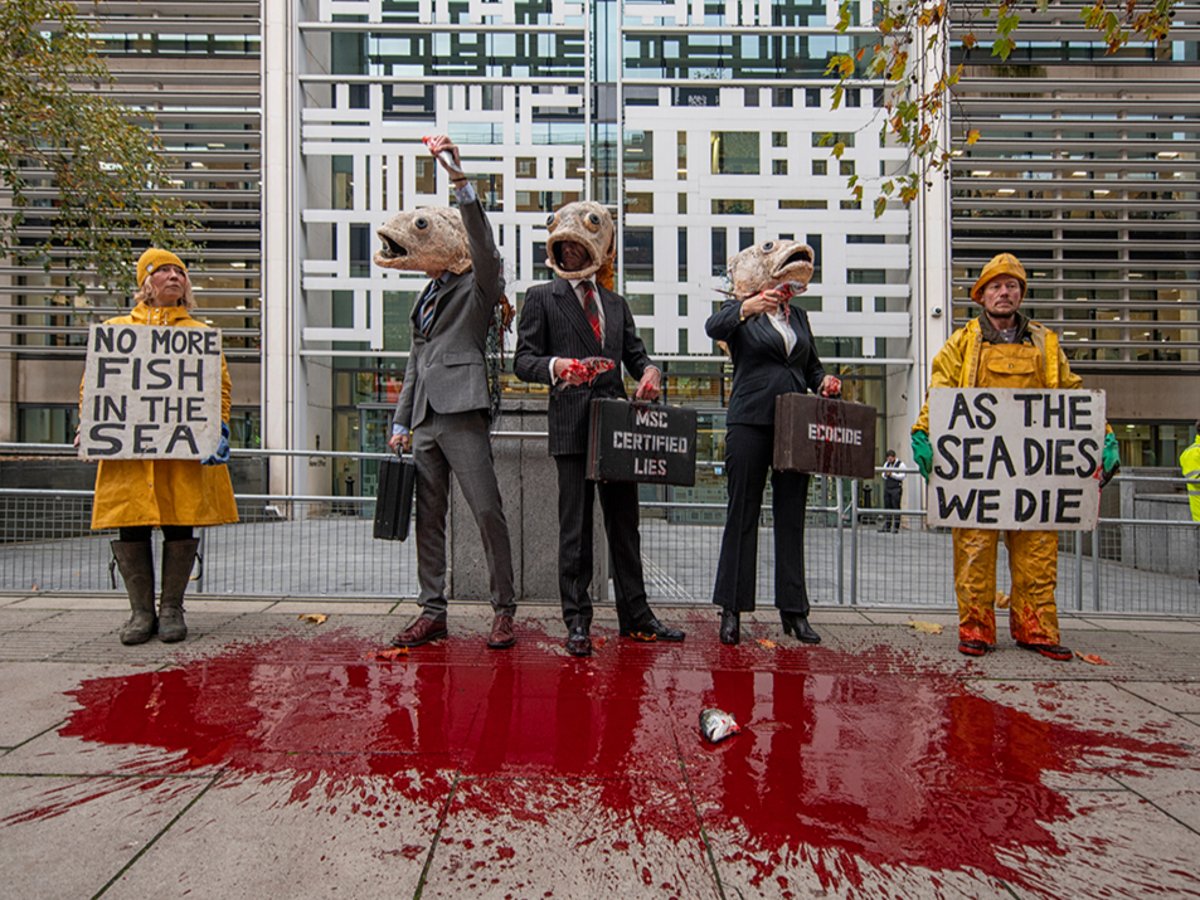Air date: week from December 10, 2021
Stream / download this segment as an MP3 file
Indigenous groups in Peru and Ecuador put forward a plan to protect 80% of the Amazon within their borders by 2025. (Photo: Global Water Forum, Flickr, CC BY 2.0)
This week, in Beyond the Headlines, Environmental Health News editor Peter Dykstra and moderator Bobby Bascomb speak about a plan by indigenous groups in Peru and Ecuador to protect 80% of the Amazon in those countries; a hidden gem in the $ 1.2 trillion infrastructure bill that will help salmon swim free; and in history a look back at a deadly fog in London.
Transcript
BASCOMB: Well, it’s time for a trip beyond the headlines with Peter Dykstra. Peter is an editor at Environmental Health News. These are ehn.org and dailyclimate.org. Hey Peter, what do you have for us this week?
DYKSTRA: Hello, Bobby. I read a news report from a great nonprofit website called Mongabay that indigenous groups are telling the Peruvian and Ecuadorian governments a plan to protect 80% of the Amazon rainforest in these two countries.
BASCOMB: Wow. 80%. That’s huge. But of course most of the Amazon is in Brazil, which is less receptive to things like that, I think.
DYKSTRA: That’s right, the Bolsonaro government is considered quite hostile to most environmental protection measures. They have their sights set on the Brazilian Amazon to increase the level of exploitation. But at least there is good news from the headwaters of the Amazon. 86 million acres could be protected if this proposal is adopted. That is only slightly smaller than the US state Montana, the fourth largest US state.
BASCOMB: Well, so that’s still huge. And I mean, there is just so much biodiversity in this part of the world. I suppose this is part of the 30 by 30 initiative to protect 30% of the world’s land and ocean areas by 2030.
DYKSTRA: It is, and it is an important piece that could be one of the first to be performed.
BASCOMB: Mm hmm. Well what else do you have for us this week?

Hidden in the Infrastructure Act, a plan to remove obstacles like culverts from the way of salmon in rivers. (Photo: USFWS Pacific Southwest, Flickr, CC BY 2.0)
DYKSTRA: Another piece of good news that was hidden in the $ 1.2 trillion infrastructure bill. If you have a $ 1.2 trillion bill, you can hide lots of little billion dollar sweet nuggets in it and few will notice. One of them is a billion dollar fund to help salmon swim freely under bridges, culverts, and other areas where anadromous fish like the salmon migrate upriver to breed. Anadromous is one of my favorite words.
BASCOMB: That’s a great word, of course, anadromous, meaning they live in the ocean for most of their lives but return to freshwater to spawn.
DYKSTRA: That’s right. The sturgeon is another example here on the east coast.
BASCOMB: And in doing so, they find that they run into many of these little obstacles along the way that this money would help remove.
DYKSTRA: Yes, artificial blockades and a road over a stream, a stream into a culvert or a tunnel. Of course, if you’re a salmon I’m not saying you are Bobby, but if you were it would be a tough swim upstream to spawn and die and keep your species alive.
BASCOMB: Yeah, it’s a tough life being a salmon these days, I’m afraid. And I know there are a lot of these little dams all over the country. You know, the big dams have been removed, like in Washington State. But there are many of these little dams that may not have been used to grind wheat in 100 years that are still standing blocking the path of many of these fish.
DYKSTRA: Or outdated dams that should generate relatively small amounts of electricity that are no longer used. The Elwha River in Washington, some of the larger ones. The Penobscot River in Maine is another. Free flowing rivers are good news for everyone, and a billion dollar investment for me.

The deadly London smog of December 1952 finally subsides after covering the city for days. (Photo: geograph.org.uk, Wikimedia Commons, CC BY-SA 2.0)
BASCOMB: Mm hmm. Yes, I have to agree with you. Well, what did you get in the history books for us this week?
DYKSTRA: On December 9, 1952, a deadly fog that had lingered over the City of London for several days finally broke. There have been up to 12,000 Londoners who may have died from the mixed effects of foggy weather plus ground-level ozone, better known as smog, and factory pollution. The US has suffered some of this. In Dinorah, Pennsylvania, just outside Pittsburgh, there was another killer mist in 1948 that struck a steel mill and a zinc smelting town in the Industrial Belt upstream from Pittsburgh.
BASCOMB: I suppose the smog, at least in London, was so bad that it is actually called pea soup. They know the air was so dirty that cars and trucks hit people when they just couldn’t be seen.
DYKSTRA: They were. London has always been a foggy place. As the industrial age began, it became a deadly foggy place, which resulted in laws even before the US passed its own air pollution laws.
BASCOMB: All right, thank you, Peter. Peter Dykstra is an editor at Environmental Health News. These are ehn.org and dailyclimate.org. We’ll talk to you again soon, Peter.
DYKSTRA: All right, Bobby, thank you very much. Bye for now.
BASCOMB: And there is more of these stories on the Living on Earth website. This is loe.org.
Left
Learn about indigenous groups protecting the Amazon
Find out more about the offer to help salmon swim free
Learn more about the deadly London fog
Living on Earth wants to hear from you!
P.O. Box 990007
Supervisory authority
Boston, MA, USA 02199
Phone: 1-617-287-4121
Email: [email protected]
Donate for life on earth!
Living on Earth is an independent media program and relies solely on input from listeners and institutions that support the public service. Please donate now to get an independent environmental vote.
Newsletter/> Living on Earth offers weekly delivery of the show summary to your mailbox. Sign up for our newsletter today!
 Sailors For The Sea: Be the variety you want at sea.
Sailors For The Sea: Be the variety you want at sea.
 Creating positive results for future generations.
Creating positive results for future generations.
 Innovations to make the world a better and more sustainable place to live. Listen to the race for 9 billion
Innovations to make the world a better and more sustainable place to live. Listen to the race for 9 billion
 The Grantham Foundation for the Protection of the Environment: Committed to protecting and improving the health of the global environment.
The Grantham Foundation for the Protection of the Environment: Committed to protecting and improving the health of the global environment.
 Energy Foundation: Serves the public interest by helping to build a strong, clean energy industry.
Energy Foundation: Serves the public interest by helping to build a strong, clean energy industry.
 Contribute to life on earth and receive as our gift an archive print of one of the extraordinary animal photographs by Mark Seth Lender. Follow the link to view Mark’s current photo collection.
Contribute to life on earth and receive as our gift an archive print of one of the extraordinary animal photographs by Mark Seth Lender. Follow the link to view Mark’s current photo collection.
 Buy a signed copy of Mark Seth Lender’s book Smeagull the seagull & support life on earth
Buy a signed copy of Mark Seth Lender’s book Smeagull the seagull & support life on earth
 PLC 4ever
PLC 4ever



